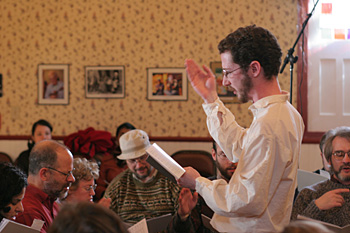Description of the Azariah Singing
On the fourth, sixty people gathered receive the Azariah story as a collection of texts and songs written in the shape note style popular in New York State in the early 1800s; presently experiencing a revival in the Northeast. Named for its unique notation system, where notes have different shapes depending on their place in the musical scale, shape note music is full-volume, full-throated, enthusiastic singing. At the Old Songs building, the site of the Albany-area annual all-day shape note singing from the Sacred Harp, participants learned to sing these songs from hand-bound Azariah tunebooks, printed especially for the singing.

The singing was led by Jesse Pearlman Karlsberg, dressed as Azariah, who opened the event by depicting the time leading up to the 22nd, speaking, in character, about the Millerite faith:
After the end of 1843, I found faith in the words of William Miller, that this was the time of the Lord's coming. That Spring, my neighbors failed to plow their fields. They knew the Lord would come before another winter. The failed prophecies of December 31, 1843, and March 21, 1844, had only strengthened our faith. The Reverend Snow predicted October 22, as the date when Jesus would return. I began to count the declining days.
On the 22nd I awoke with a bitter taste in my mouth. I spent the day sitting with my family, singing from the Millenial Harp, but I needed to be alone. At dusk, my head spinning, I opened the front door and stepped into the cold air.

After teaching the rudiments of shape note singing and practicing the major scale, Jesse led the group singing the first song, "Expectation," which depicted Azariah in his home town of Fayette, NY, at dusk on October 22. After the bitter disappointment of Jesus' failure to return, Jesse and the group followed Azariah as he fell ill, and one morning found his room full of ancient prophets in the songs "Assembled Prophets" and "Waking." Collectively, we witnessed Azariah as he recovered, and felt the call of the forest near Cayuga Lake. There, through a series of encounters with the prophets, beginning with the song "Cayuga Glade," he begins to learn the strange songs the prophets sing.
The story follows Azariah to a culminating encounter, where he is led to a clearing by the prophet Sabbatai Zevi, in which he finds a fallen tree with a strange cavern by its roots. This encounter is described in the songs "Sabbatai Zevi" and "Fallen Tree." In "Mouth of Stone," Azariah climbs inside the cavern and falls asleep, and in "Plants of Flesh," as he sleeps, the cavern closes, and his body, torn to a thousand parts, seeps through the dirt. Each "plant of flesh" shoots out a beam of light which creates a celestial telegraph line to one of the prophets. In "Forest's Edge," the story's final song, Azariah awakes reconstituted, lying at the base of the fallen tree, his head swimming with the prophets songs. He walks to the forest's edge and falls asleep, singing the whole time. He wakes, still singing, surrounded by villagers from Fayette, his mother sitting by his side, transcribing the songs as he sings them.